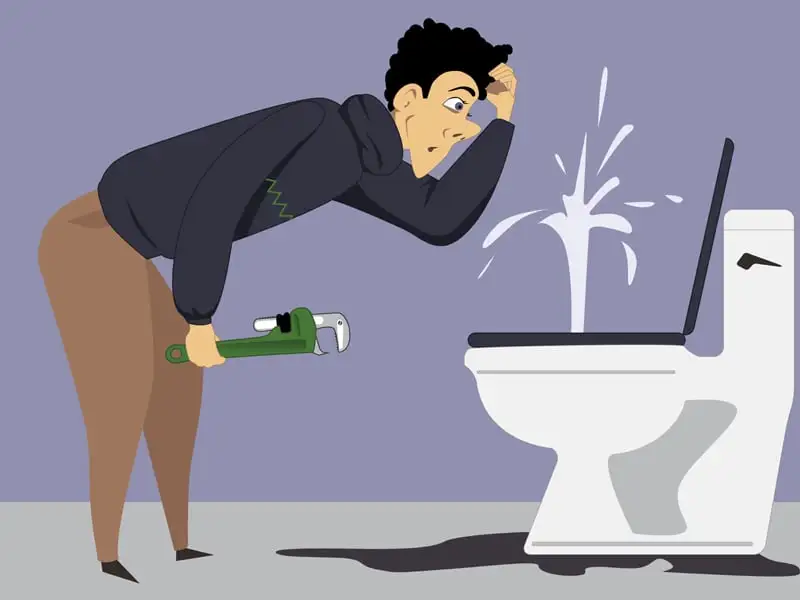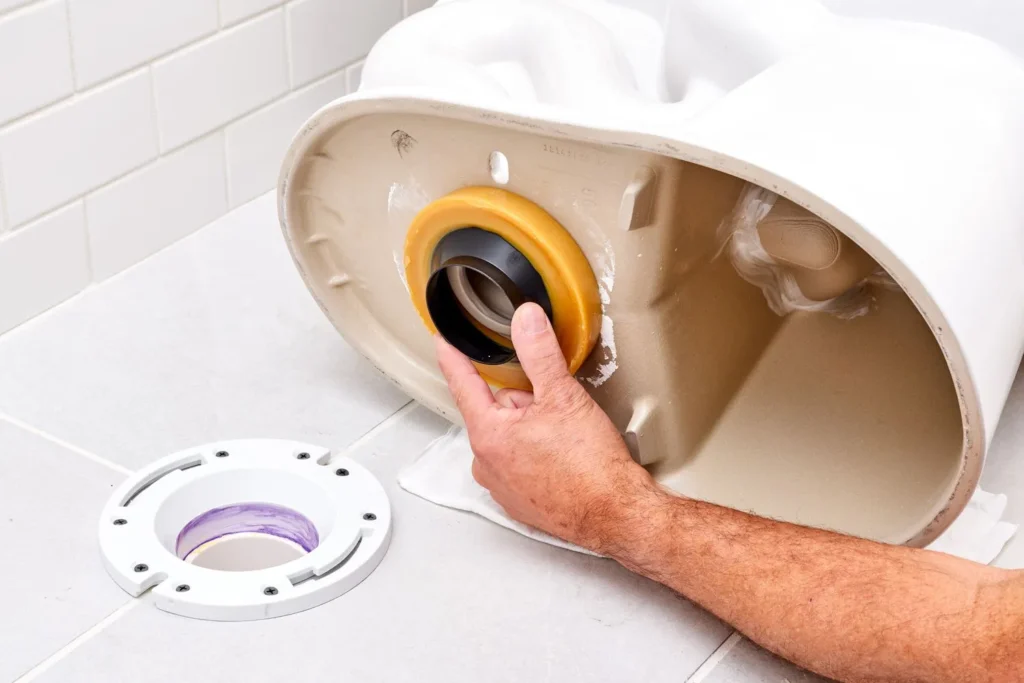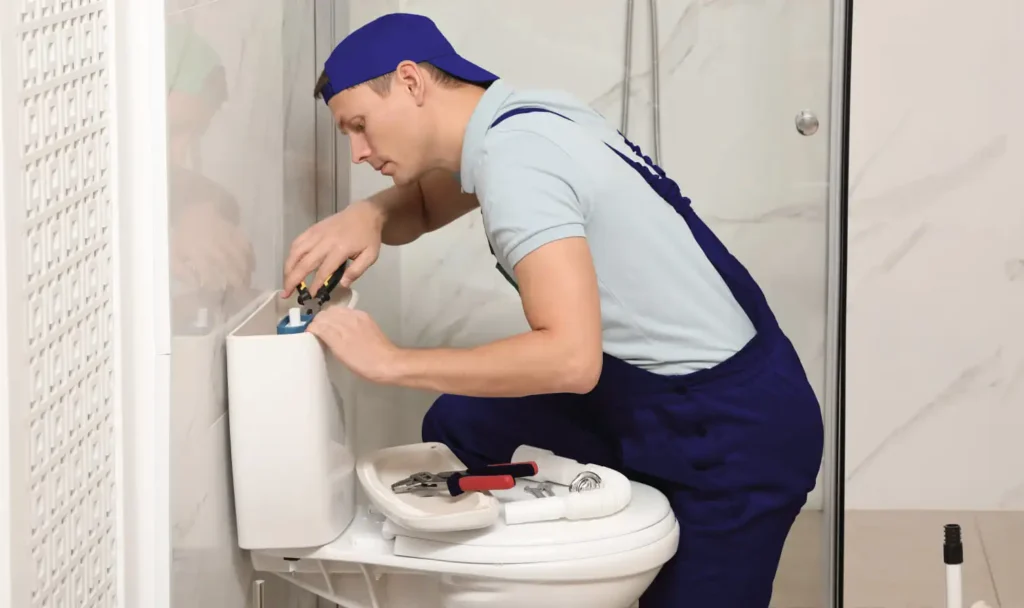
As a professional plumber with over years of experience here at SJS Plumbing, we’ve seen a fair share of leaking toilets in Caroline Springs. While a minor annoyance at first, leaking toilets can waste hundreds of litres of water a month, driving up your water bill and potentially causing damage to your bathroom floor.
The good news is that most leaking toilet problems have simple solutions! In this blog, we’ll explore the 10 most common culprits behind a leaky loo and how a qualified plumber from SJS Plumbing can quickly diagnose and fix the issue, saving you water, money, and frustration.
1. The Worn-Out Flapper:
The humble flapper valve, a simple piece of rubber or plastic nestled at the bottom of your toilet tank, plays a crucial role in maintaining peace and quiet (and dryness) in your bathroom. However, over time, this silent saboteur can wear out, leading to a constant trickle of wasted water and a higher water bill.
Signs of a Worn-Out Flapper:
- The tell-tale hiss: A constantly running toilet is a classic sign of a faulty flapper. You might hear a faint hissing sound coming from the tank, indicating water is leaking past the flapper and into the bowl.
- Higher water bills: A leaky flapper can waste hundreds of litres of water per month, leading to a noticeable increase in your water bill.
- Weak flushes: If the flapper isn’t sealing properly, it may not allow enough water to flow into the bowl for a powerful flush. You might need to press the handle multiple times to achieve a complete flush.
2. The Faulty Fill Valve:
The fill valve, another unsung hero of your toilet tank, is responsible for maintaining the proper water level. When functioning correctly, it fills the tank to a designated point and then shuts off automatically, preventing overflows. However, a faulty fill valve can become a nemesis of your toilet, causing overflows and wasted water.
Signs of a Faulty Fill Valve:
- Constantly Running Toilet: This is the most common sign of a faulty fill valve. If the shutoff mechanism malfunctions, the water will continue to flow even after the tank is full, causing it to overflow into the bowl and creating a constant running sound.
- Overflowing Tank: A telltale sign of a faulty fill valve is water overflowing from the tank itself, potentially causing damage to the bathroom floor or surrounding areas.
- High Water Level in the Tank: If the water level in the tank seems significantly higher than usual, it could indicate the fill valve isn’t shutting off properly.
3. Loose Tank Bolts:
Imagine settling down on your toilet, only to feel a slight wobble. This unsettling experience might be caused by loose tank bolts, the silent culprits behind leaks and potential instability.
Signs of Loose Tank Bolts:
- Wobbling Tank: The most obvious sign is a tank that rocks slightly when you sit on it. This can be unnerving and indicates the bolts are no longer holding the tank securely.
- Leaks Around the Base of the Tank: Loose bolts can compromise the watertight seal between the tank and the bowl, allowing water to seep through and leak onto the bathroom floor.
- Cracked Wax Ring: Over time, the constant pressure of a loose tank can put stress on the wax ring, the waxy seal between the toilet flange (the pipe outlet in the floor) and the toilet base. This can lead to cracks in the wax ring, potentially causing leaks.
4. The Deteriorated Wax Ring:
The wax ring, a seemingly insignificant component nestled between the toilet base and the drainpipe flange in the floor, plays a crucial role in your toilet’s functionality. This waxy seal acts as a silent guardian, preventing leaks and ensuring a watertight connection. However, over time, the wax ring can deteriorate, leading to a silent but potentially costly problem.
Signs of a Deteriorated Wax Ring:
While the wax ring itself isn’t readily visible, there are signs that may indicate it’s failing:
- Leaks Around the Base of the Toilet: Water pooling around the base of the toilet, especially after flushing, is a strong indicator of a leaking wax ring.
- Sewage Odours: A broken wax ring can allow sewer gases to escape, causing unpleasant odours in your bathroom.
- Wobbling Toilet: In some cases, a deteriorated wax ring can lose its ability to create a stable connection, leading to a slight rocking sensation when you sit on the toilet.

5. Cracks in the Toilet:
A toilet, while appearing sturdy, is not invincible. Cracks in the porcelain can develop for various reasons, compromising the integrity of the toilet and potentially leading to leaks and even worse, complete failure.
Types of Toilet Cracks:
- Hairline Cracks: These are thin cracks that may appear on the toilet tank or bowl. While they might not cause immediate leaks, they can weaken the porcelain over time.
- Stress Cracks: These cracks can develop due to improper installation, loose tank bolts, or excessive weight on the toilet.
- Cracked Toilet Bowl: This is a serious issue, as the toilet bowl bears the brunt of the weight and pressure. A cracked bowl can leak or even shatter completely.
Signs of Cracks in the Toilet:
- Visible Cracks: Carefully inspect the toilet tank and bowl for any visible cracks, both on the inside and outside surfaces.
- Leaks Around the Toilet: Leaks originating from the tank or bowl can indicate a crack in the porcelain.
- Stains or Discoloration: Water seeping through cracks can cause stains or discolouration around the base of the toilet.
6. Condensation on the Tank (Not a Leak!):
Have you noticed water droplets forming on the outside of your toilet tank? While it might look like a leak, this is often a common phenomenon called condensation, and it’s not necessarily a cause for alarm.
Signs of Condensation:
- Water Droplets on the Outside of the Tank: The most obvious sign is the presence of water droplets forming on the exterior surface of the toilet tank.
- Cold Tank: The tank itself may feel cool to the touch compared to the surrounding bathroom air.
7. Blocked Overflow Tube:
The overflow tube in your toilet tank is often an unsung hero. This small pipe acts as a safety measure, preventing the tank from overflowing if the fill valve malfunctions. However, if the overflow tube itself becomes clogged with debris, it can turn from hero to villain, causing leaks and other problems.
Causes of a Blocked Overflow Tube:
- Mineral Deposits: Hard water can leave behind mineral deposits that accumulate in the overflow tube over time.
- Debris: Small objects like toilet tank cleaning tablets, or even small toys from young children, can fall into the tank and become lodged in the overflow tube.
- Deteriorating Flapper: A worn-out flapper can allow small particles to bypass it and enter the overflow tube, eventually causing a blockage.
Signs of a Blocked Overflow Tube:
- Constantly Running Toilet: If the overflow tube is blocked, the water filling the tank can’t escape through the usual route and may overflow from the tank into the bowl, causing the toilet to run continuously.
- Water Leaks Around the Tank: A blockage can also cause water to back up and leak out from around the base of the toilet tank.
- Slow Filling Tank: In some cases, a partial blockage can restrict the flow of water into the tank, causing it to fill slowly.
8. Corroded Toilet Parts:
Internal toilet parts are constantly exposed to water, and depending on your water quality, this can lead to a silent threat: corrosion. Mineral deposits in hard water can slowly eat away at metal components within the toilet tank, causing leaks that may not be readily apparent.
Commonly Corroded Parts:
- Fill Valve: The fill valve controls the water level in the tank. Corrosion can damage the internal mechanisms, leading to malfunctions like overfilling or sticking, which can cause leaks from the overflow tube or the tank itself.
- Flush Valve Assembly: Metal components within the flush valve, like the flapper arm or the flush handle lever, can corrode and weaken over time. This can lead to leaks at the base of the flush valve or difficulty flushing properly.
- Supply Line Connection: The metal connection points where the braided supply line meets the shut-off valve and the fill valve are susceptible to corrosion, especially if the connection wasn’t properly sealed during installation.
Signs of Corrosion in Toilet Parts:
- Visible Rust or Green Build-Up: Inspect the metal parts inside the tank for any signs of rust or a greenish buildup, which indicates mineral deposits.
- Leaks: While leaks can have other causes, unexplained leaks could be a sign of corroded internal components.
- Difficulty Flushing: Corrosion can weaken the flush valve, leading to weak flushes or the need for multiple flushes.
- Premature Failure of Parts: If parts like the fill valve or flush valve seem to need replacing more frequently than expected, corrosion could be the culprit.
9. Worn Out Flush Valve:
The flush valve plays a crucial role in your toilet’s operation. It controls the release of water from the tank to the bowl, ensuring a powerful and efficient flush. However, over time, the flush valve can wear out, leading to leaks and flushing problems.
Two main components within the flush valve assembly can succumb to wear:
- Flush Valve Seal: This rubber seal creates a watertight barrier between the tank and the flush valve body. With age and constant use, the seal can become brittle, cracked, or misaligned, allowing water to leak from the base of the flush valve into the tank.
- Flush Valve Flapper Chain: This chain connects the flush handle to the flush valve and lifts the flapper to release water when you press the handle. The chain can become weak, stretched, or even detached, preventing the flapper from lifting properly and causing a weak flush or even a constantly running toilet.
Signs of a Worn-Out Flush Valve:
- Weak Flush: If your toilet struggles to properly flush waste, it could be due to a worn-out flush valve seal or a weak chain.
- Constantly Running Toilet: A damaged flush valve seal that allows water to leak past can cause the toilet to run continuously to refill the tank.
- Noisy Flushes: A worn-out flush valve may create a louder-than-usual noise when flushing.
10. Faulty Supply Line:
The supply line, typically a braided metal hose, connects the shut-off valve to the toilet fill valve. Over time, these hoses can develop leaks due to several factors:
- Normal Wear and Tear: Constant water pressure can weaken the hose material, especially if it’s low quality.
- Corrosion: Mineral deposits in your water supply can cause the metal components of the supply line to corrode, leading to pinhole leaks.
- Improper Installation: If the supply line wasn’t installed correctly or wasn’t tightened enough at the connections, it can leak at the attachment points.
Signs of a Faulty Supply Line:
- Visible Bulges or Cracks: Inspect the length of the hose for any bulges or cracks in the metal braiding.
- Leakage at the Connection Points: Check for water pooling around the connection points where the hose attaches to the shut-off valve and the fill valve.
- Hissing Sound: Sometimes, a faulty supply line can create a hissing sound near the connection points.
SJS Plumbing: Your One-Stop Shop for All Your Leaking Toilets Repair in Caroline Springs

Don’t let a malfunctioning toilet disrupt your day! At SJS Plumbing in Caroline Springs, we’re your trusted experts for a wide range of leaking toilet repairs and maintenance services. Our experienced and licensed plumbers can diagnose and address any toilet issue you might encounter, ensuring your toilet functions optimally and efficiently.
Here’s a look at some of the common toilet problems we can fix:
- Worn-Out Flapper: A faulty flapper can lead to a constantly running toilet, wasted water, and higher water bills. Our plumbers can quickly replace your flapper with a high-quality, efficient model.
- Faulty Fill Valve: A malfunctioning fill valve can cause overflows, leaks, and improper tank filling. We can repair or replace your fill valve to ensure proper water level control.
- Loose Tank Bolts: Loose tank bolts can create a wobbly toilet and potentially lead to leaks around the base of the tank. Our plumbers will securely tighten the bolts or recommend replacing them if necessary.
- Deteriorated Wax Ring: Over time, the wax ring that seals the connection between the toilet and the drainpipe flange can deteriorate, causing leaks and unpleasant odours. We can expertly remove the old wax ring and install a new one, ensuring a watertight seal.
- Cracks in the Toilet: Hairline cracks may not require immediate replacement, but larger cracks or cracks in the bowl can signify a failing toilet. Our plumbers can assess the crack and recommend the best course of action, whether it’s repair or replacement.
- Condensation on the Tank: While not a plumbing issue itself, condensation on the toilet tank can be unsightly. We can advise you on strategies to minimise condensation in your bathroom.
Why Choose SJS Plumbing?
- Fast and Reliable Service: We understand that a malfunctioning toilet can be inconvenient. That’s why we offer prompt service to diagnose and fix your toilet problems quickly and efficiently.
- Upfront Pricing: We believe in transparent pricing. You’ll receive a clear quote before we begin any work, so there are no hidden surprises.
- High-Quality Workmanship: Our licensed plumbers use the latest tools and techniques to ensure all repairs and installations are completed to the highest standards.
- Guaranteed Satisfaction: We stand behind our work with a guarantee on all parts and labour, giving you peace of mind.
